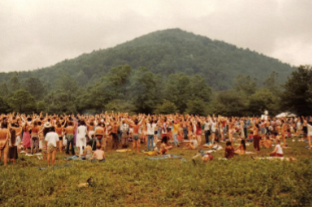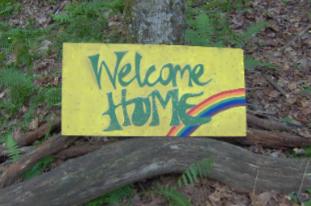Rainbow Gatherings harken back to the counterculture movement of the 1960s. These communal get-togethers bring together loosely affiliated folk to celebrate shared ideologies and utopian traditions. Participants believe that modern lifestyles and governance are exploitative and out of harmony with nature. Two concepts widely shared are ‘community’ and ‘living close to the land’. These ideals are manifested in the gathering by temporarily living outdoors, preparing and sharing food in communal kitchens, the use of low tech methods-specifically for procuring fresh water and disposing of human waste, and congregating in large numbers on undeveloped land for a variety of activities. Unfortunately these activities have had dire consequences in past reunions.
In July 1987, a large outbreak of shigellosis occurred among Rainbow attendees. Shigellosis is a disease caused by the bacterium, Shigella. Symptoms in sufferers include bloody diarrhea, stomach cramps and fever. Because sanitation in the campsite was poor, the disease spread widely, probably by multiple means: food, water and person-to-person (fecal-to-oral transmission). Among the estimated 12,700 people gathered, over half were infected. The Shigella strain was isolated by health department officials and found to be resistant to at least three common antibiotics including ampicillin and tetracycline. The outbreak was more widely dispersed when participants left the gathering and spread the disease nationwide. Outbreaks in three states were later linked to transmission from Rainbow campers.
An article published in the Journal of Infectious Diseases documented where the 1987 Rainbow Gathering went wrong:
Approximately 13,000 people crowded together on 99 acres of undeveloped forest and open fields. That translates into 128 individuals per acre. To put it into perspective, in 2010, New York City had an average of 42 persons/acre across all boroughs.
· Drinking water was taken from environmental surface waters using plastic tubing and consumed directly. These same waters were used for swimming and bathing.
· Group child care was provided at a site upstream from most of the campsite and from the site of drinking water collection.
· Prior to the event, the North Carolina Department of Health Services (NCDHS) tested these waters and found high levels of coliforms, bacteria used to estimate human fecal contamination.
· Because of the high coliform levels, ‘boil water’ signs were posted by NCDHS, but few campers complied.
· Food was prepared in 47 different communal kitchens without regard to hand-washing or excluding sick individuals from food preparation.
· Bathrooms were shallow trenches, which were frequently near these kitchens and not well maintained.
· Many shunned the shallow trenches for elimination and used more casual sites.
· Many who attended had no experience in primitive camping.
· It rained frequently during the event, which hastened the contamination of water sources.
The 1987 gathering is representative of the long history of outbreaks associated with food- and water-borne pathogens at the gathering. Despite repeated pathogenic outbreaks, more recent gatherings have not learned from past missteps in planning and sanitation. Another Shigella outbreak occurred at the gathering in Poland in 2018, and a typhoid fever outbreak was documented in Italy in 2017. In Montana at the 2013 gathering, the local county hospital estimated that uncollectible charges for emergency room care for campers were about $175,000. Websites, books and blogs by past attendees mention contracting giardia, a tiny parasite causing long-term intestinal distress, as a very real possibility at the gatherings.
 The Gathering can bring together thousands of people which can overwhelm natural sites by causing erosion to meadows and forests. Foot traffic degrades stream banks, churning them into a muddy mess. Ground cover is damaged due to this over-capacity which results in more run-off. Mud and silt further reduce the quality and safety of water. While environmentalism is a major ideal of most participants, these events are usually held in ecologically sensitive areas and actually are detrimental to the local flora and fauna.
The Gathering can bring together thousands of people which can overwhelm natural sites by causing erosion to meadows and forests. Foot traffic degrades stream banks, churning them into a muddy mess. Ground cover is damaged due to this over-capacity which results in more run-off. Mud and silt further reduce the quality and safety of water. While environmentalism is a major ideal of most participants, these events are usually held in ecologically sensitive areas and actually are detrimental to the local flora and fauna.
Federal lands are usually the sites chosen for the yearly gatherings. Representatives of federal and state agencies as well as local departments of health and human services have traditionally tried to assist the celebrants with food safety and public hygiene. However, assistance is not always welcome and laws governing health and safety provisions at mass gatherings are difficult to enforce among the wandering denizens of the camp. In 2022, precisely how many will come to the Rainbow Gathering and where exactly they will congregate in the Centennial State is still unclear. “We want to assure the community that we are working with our partners and cooperators to prepare for the possibility of a large, extended gathering in Colorado,” said Forest Service spokeswoman Reid Armstrong. Other governmental officials aren’t so positive: “It really concerns me that it’s for a full month, there’s not a real good way to prepare for it,” ventured Jackson County Sheriff Jarrod Poley.
If you, or someone you know, plans to attend this year, seek or accept guidance from park officials and health authorities. They have your best interests at heart. This summer, whether you attend a large gathering or just hike by yourself or with a few trail buddies, remember this: wash your hands with clean water, only drink potable or treated water, use sanitary facilities well away from surface waters to dispose of human waste, prepare food safely as you would at home, and reduce your impact on the environment by packing out your trash and gathering only in small groups. It’s not nice to fool Mother Nature.
Caption, ABOVE PHOTO: Ohm circle at Rainbow Gathering July 4, 1980 in West Virginia.




